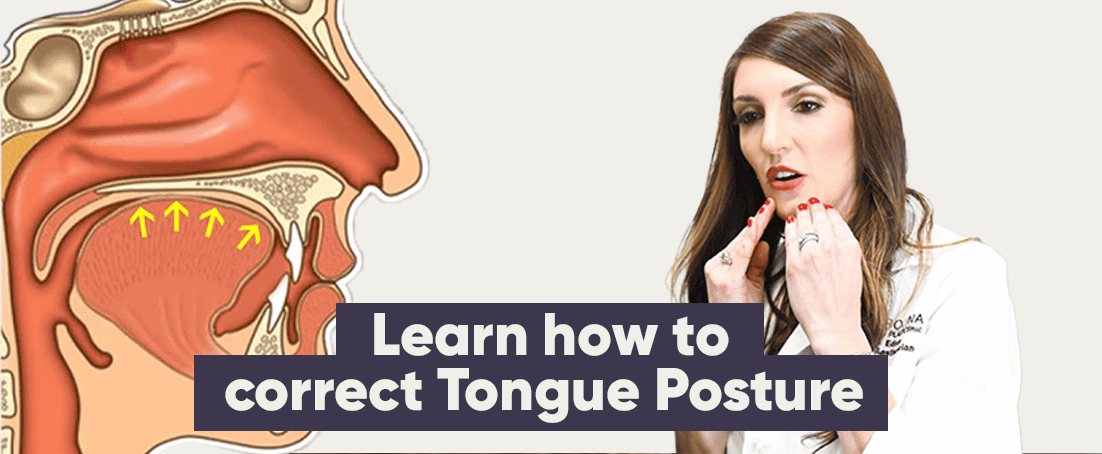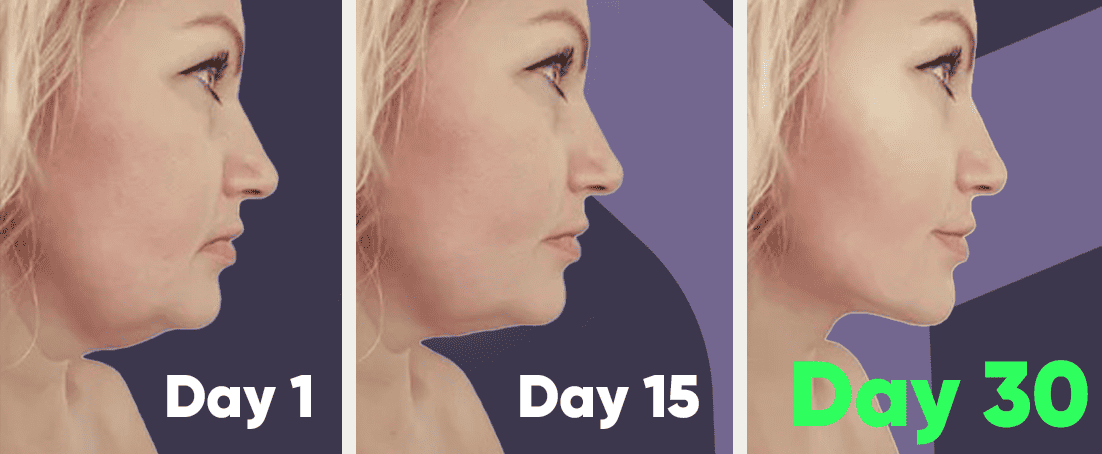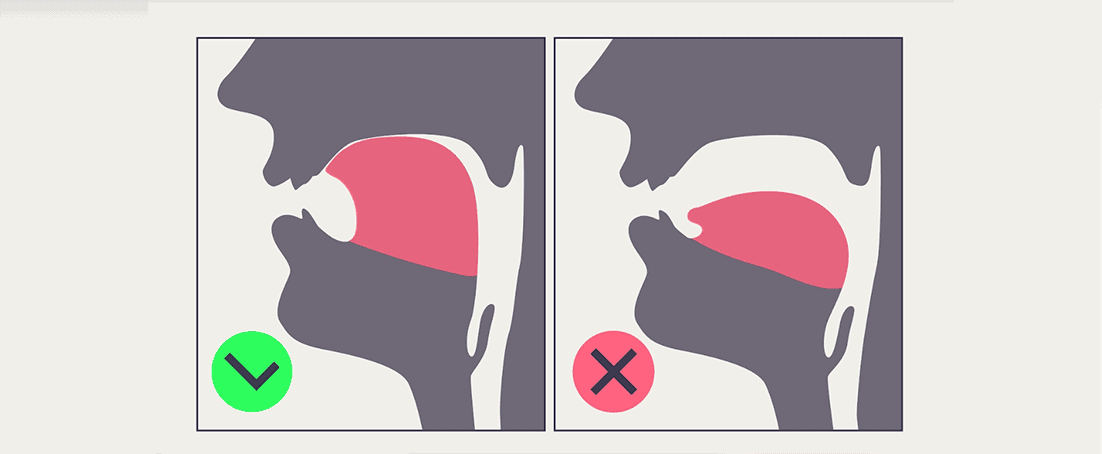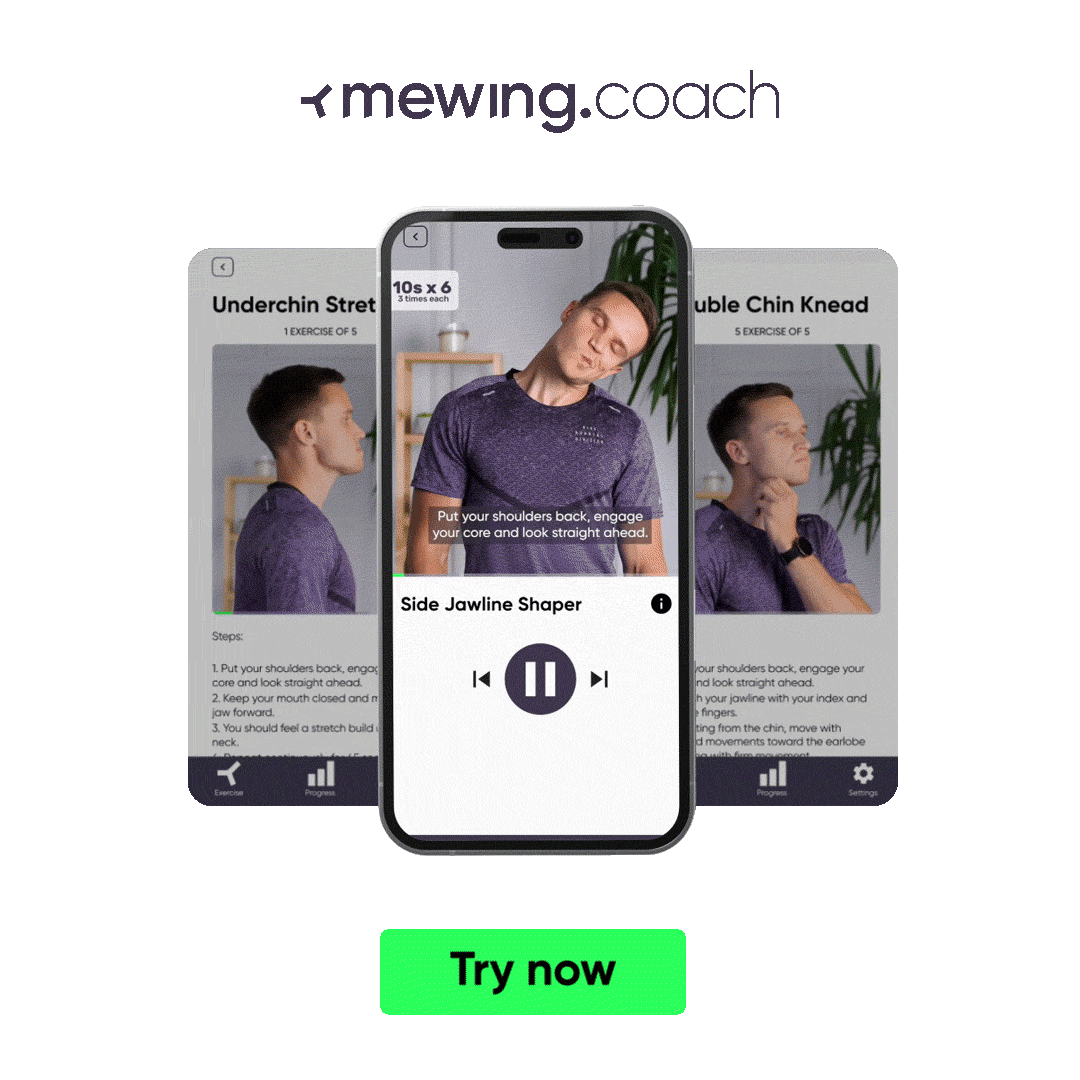
Correct body posture is what we teach children and adults, with slouching being the worst possible thing you can do for your health and as a sign of bad manners.
But what about your tongue? Have you ever thought about your tongue posture? What if your tongue is “slouching?”
Well, mewing has the answer to this and more.
Skip the long read! Take a short quiz below and learn how Mewing.coach app can help you achieve proper tongue posture fast and easy.
🔎 Revealed on this page:
- 📝 Correct mewing tongue posture: An extensive explanation of the role of correct tongue positioning and its benefits.
- 📖 A detailed guide and illustrations on achieving proper tongue posture via mewing. We’ll guide you step-by-step through the technique and how to do it properly.
- 👀 Pictures of before and after learning tongue posture with mewing.
Sounds interesting?
Read on!
What Is Correct Tongue Posture?
Tongue posture is the tongue’s natural resting position – when the mouth is not engaged in any activity, like talking or chewing.
Correct tongue posture means the tip of the tongue is flattened on the roof of the mouth behind the front incisors without touching them. A seemingly simple concept, yet many people seem to encounter problems attempting it.
It’s essential to learn how to rest your tongue in the right position and correct any imperfections, as proper tongue posture can save you from many health scares.
Why Is Correct Tongue Posture Important?
The tongue is the most powerfully-built muscle in the mouth, and its position plays a key role in protecting your oral health and body wellness.
Tongue posture dictates:
- How the face is formed
- How your teeth align
- How you breathe.
Tongue posture helps straighten your teeth by widening the upper jaw, whereby teeth have enough space to grow in proper alignment. When your tongue sinks to the bottom of your mouth or deviates from the correct position, your upper jaw narrows, leading to overcrowded and crooked teeth and decay.
By doing mewing tongue posture exercises, you will be able to avoid many of these issues and see improvement in your overall health.

Benefits of Correct Tongue Posture
Practice has shown that proper mewing tongue posture has many benefits.
Here is a list of some of the problems that tongue posture can resolve:
- 👍 Receding and double chin
- 🦷 Crooked teeth
- 🦷 Overbite, underbite, crossbite and open bite
- 🗣️ Speech disorders
- 👄 Mouth breathing
- 💤 Snoring
- 🌙 Sleep apnea
- 💪 TMJ
- 🍎 Swallowing problems
- 👃 Sinus inflammation.
One of the most important benefits of tongue posture is alleviating snoring by opening the airway and allowing for nasal breathing instead of mouth breathing. This can further save you from other serious health scares caused by sleep apnea.
Still, the principal reason people take up mewing and learn oral posture is the increased interest in improving their jawline and facial structure.
Can Tongue Posture Improve Facial Features?
In short, yes.
If the tongue rests on the lower jaw and at the back of the throat, it pulls the face down and backward. Putting pressure on the jaw may cause a receding chin, asymmetrical facial features, a narrower mouth, and crowded teeth.
All these factors are of aesthetic significance and can contribute to issues with proportional facial features and aesthetically pleasing appearance. Proper tongue position can help you define your jawline, making it more prominent and attractive.

Results of Mewing and Correct Tongue Posture

Throughout the years of practice, there have been numerous accounts of successful results achieved by mewing. There are recounts of improved health conditions and photos to show pronounced jawlines and overall positive effects on physical appearance.
People have reported numerous changes in their features after learning how to position their tongues properly. The effects are seen in the improvements of receding jaws, loss of double chin, and alignment of the face.
The before and after correct tongue posture transformations are undeniable and reported daily by satisfied proponents of the mewing technique.

Correct Tongue Posture Mewing Diagram
It is essential to distinguish between correct and incorrect tongue posture. You need to become aware of what is happening in the mouth in order to be able to correct it.
The diagram illustrates the right and wrong way to position your tongue.
Correct mewing tongue posture:
- The tongue is lifted and pressed gently on the roof of the mouth, about half an inch away from the front teeth
- The posterior third of the tongue also touches the palate but does not block the airway
- The mouth is closed
- The teeth are slightly separated and not touching.
- Nasal breathing.
Incorrect tongue posture:
- The tongue is left lying flat on the bottom of the mouth
- The posterior 3rd of the tongue is drawn to the back of the throat, blocking the airway
- The mouth is slightly open
- Mouth breathing.

Dangers of Incorrect Tongue Posture
Improper tongue position is the root cause of many health issues connected with jaw alignment and mouth breathing – ranging from a narrow maxilla and crooked teeth to sleep apnea and high blood pressure.
Aesthetic concerns – such as double chin, recessed jawline, and facial alignment – closely connected to improper oral posture are another reason to address this problem.
To avoid health complications without resorting to oral and maxillofacial surgery, you should practice the mewing method for tongue placement. Mewing can help you learn how to maintain tongue posture and relieve any of these problems.
Causes of Incorrect Tongue Posture
Childhood habits and certain health conditions can contribute to incorrect tongue posture:
Thumb Sucking and Pacifier Use
Thumb sucking and pacifiers can cause misalignment of the child’s permanent teeth, affecting the shape of the jaw and the roof of the mouth. It is the number one cause of bite problems and speech impediments.
Soft Foods
The act of chewing plays a key role in developing and strengthening the jaw muscles. Less solid food requires less chewing. And this results in weak jaw muscles and the inability to hold the jaw in the right position.

Chronic Nasal Obstruction
Allergies, enlarged tonsils, and a deviated septum cause nasal congestion, leading to mouth breathing. Long-term inability to breathe properly turns into a habitual incorrect tongue posture.
Bad Habits
Tongue posture is a matter of habit. A child may not learn how to properly position the tongue and keep that habit well into old age.
Learn Correct Tongue Posture in 5 Easy Steps
British orthodontist John Mew is the creator of the orthotropics method, which was consequently named after him. Along with his son, Mike Mew, they developed the mewing tongue posture exercises, which promote facial alignment and relieve health concerns.
First, learning the proper mewing technique is paramount to help you maintain a correct tongue position. Whether you are a beginner or an experienced mewer, it is good to go through the basics of this method. You can take a look at our mewing tutorial for a more detailed guide on mewing.
The mewing technique of correct tongue placement can be done in 5 easy steps:
- Close your mouth, seal your lips, and allow your teeth to touch gently
- Move your tongue to the roof of the mouth and lightly press it
- You should feel a little pressure throughout the palate
- Engage your posterior third of the tongue
- Make sure you are not blocking the airway and breathe through your nose
If you have acquired this mewing tongue posture, then congratulations are in order.
Beginners can be unsure if they have learned proper tongue position or not. They usually can’t identify the posterior third back of the tongue and whether it is touching the palate.
Look at the list of things to consider in order to identify any mistakes while practicing the mewing method:
- Make sure the tip of your tongue is separated from your front teeth
- Open your mouth and try mouth breathing. If you can breathe through your mouth, you’re doing it wrong
- Tongue pressure is evenly distributed on the roof of the mouth
- Teeth are not clenched but are lightly touching
- You can breathe through your nose
What If I Struggle With Correct Tongue Posture?
There are cases when mewing exercises can be hard to do. People who struggle with mewing usually report tongue tie – a congenital condition restricting tongue movement.
There is a buildup of tissue connecting the bottom of the mouth and the tip of the tongue, holding it firmly in place. People with this condition cannot stick their tongues out, affecting their speech, eating, and swallowing.
Mewing Coach has a solution for that, too, as we have designed a program for people that want to try mewing with tongue tie. A simple yet very effective and fun activity called tongue chewing can help you stretch your tongue.
The tongue chewing benefits for mewing are incredible as they allow you to feel the pressure against the hard palate and become aware of the position of the posterior third part.
Conclusion
While correct mewing is hard to achieve, it’s in no way impossible! Try some of our top tips and thoroughly review each step before committing to the exercise. Alternatively, use our Mewing.coach app, and never worry about doing mewing wrong again!




